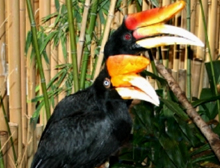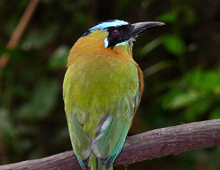
This bird is dependent on the continued existence of old growth forests in Southeast Asia. Outside the breeding season, it eats a wide variety of fruits, supplemented with small animals while it raises chicks. The nest is a deep hole in a tall tree into which the female is sealed by the male, with a cement-like mixture of mud, feces and fruit; she remains inside for weeks. Except for their eye color (males have red eyes and females have white eyes), males and females look alike. Not bred in captivity until 1986, this species is now managed as an international zoo population.



